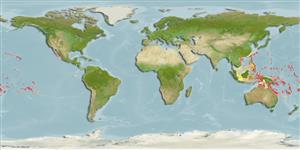>
Blenniiformes (Blennies) >
Blenniidae (Combtooth blennies) > Salariinae
Etymology: Cirripectes: Latin, cirrus = curl fringe + Greek, pektos, -e, -on = made of several parts solidly united (Ref. 45335).
More on author: Valenciennes.
Environment: milieu / climate zone / depth range / distribution range
Ekologi
laut berasosiasi dengan karang; kisaran kedalaman 0 - 31 m (Ref. 529), usually 1 - 5 m (Ref. 58302). Tropical; 28°N - 28°S
Pacific Ocean: Palau to Johnston Islands, Marquesas and Pitcairn Islands, north to the Bonin Islands, south to Rapa; throughout Micronesia.
Length at first maturity / Size / Weight / umur
Maturity: Lm ?, range 6 - ? cm
Max length : 8.9 cm SL jantan/; (Ref. 529)
Duri punggung (Keseluruhan (total)) : 11 - 13; duri punggung lunak (Keseluruhan (total)) : 13 - 15; Duri dubur: 2; Sirip dubur lunak: 14 - 16; vertebrata, bertulang belakang: 29 - 31. Dorsal fin XII, 14, membrane attached to caudal fin, with deep notch above last spine, first spine slightly higher than second; anal fin II, 15; pectoral rays 15; pelvic fin I, 4; caudal fin procurrent rays 10-14. Vertebrae 10 + 20. LL, without scales but with scalelike flaps; LL tubes 1-11, canal ends below 7th dorsal ray and caudal-fin base. Lower lip smooth mesially, plicate laterally. Upper lip crenulae 37-51. Gill rakers 23-29. Cephalic pore system complex; midsnout pores present. Cirri, supraorbital 4-14, nasal 4-19; nuchal 27-38, in 4 groups, bases of ventralmost groups slightly expanded. Adults with brown body; red spots or narrow lines on snout and around the eye; iris silvery (Ref. 529). Anterior nare is tubular and provided with an apical lid that prevents the penetration of sand particles (Ref. 94108).
Facultative air-breathing in the genus (Ref. 126274); Adults inhabit exposed seaward reefs where it usually shelters at bases or among the branches of Pocilloporid corals (Ref. 1602). Feeds on benhic algae (Ref. 89972). Benthic (Ref. 58302). Oviparous. Eggs are demersal and adhesive (Ref. 205), and are attached to the substrate via a filamentous, adhesive pad or pedestal (Ref. 94114). Larvae are planktonic, often found in shallow, coastal waters (Ref. 94114).
Oviparous, distinct pairing (Ref. 205). Urogenital orifice of male genital papilla located basally between 2 widely separated slender filaments on a fleshy swelling behind anus; testes bulbous with length equal its width (Ref. 529).
Williams, J.T., 1988. Revision and phylogenetic relationships of the blenniid fish genus Cirripectes. Indo-Pac. Fish. (17):78 p. (Ref. 529)
Status IUCN Red List (Ref. 130435: Version 2024-2)
ancaman kepada manusia
Harmless
penggunaan manusia
Perikanan: tidak ada kepentingan; Akuarium: Komersial
Alat, peralatan
laporan khas
muat turun XML
Sumber internet
Estimates based on models
Preferred temperature (Ref.
123201): 24.9 - 29.3, mean 28.2 °C (based on 1525 cells).
Phylogenetic diversity index (Ref.
82804): PD
50 = 0.5000 [Uniqueness, from 0.5 = low to 2.0 = high].
Bayesian length-weight: a=0.01047 (0.00461 - 0.02381), b=2.98 (2.79 - 3.17), in cm total length, based on LWR estimates for this (Sub)family-body shape (Ref.
93245).
Trophic level (Ref.
69278): 2.0 ±0.00 se; based on food items.
Daya lenting (Ref.
120179): Tinggi, Waktu penggandaan populasi minimum kurang dari 15 bulan (Preliminary K or Fecundity.).
Fishing Vulnerability (Ref.
59153): Low vulnerability (10 of 100).
Nutrients (Ref.
124155): Calcium = 138 [72, 238] mg/100g; Iron = 0.908 [0.544, 1.483] mg/100g; Protein = 18.3 [17.1, 19.3] %; Omega3 = 0.142 [0.085, 0.234] g/100g; Selenium = 23.5 [12.9, 45.9] μg/100g; VitaminA = 127 [36, 437] μg/100g; Zinc = 2.58 [1.75, 3.68] mg/100g (wet weight);
